Related Research Articles

The Triumph Rocket III is a three-cylinder motorcycle made by Triumph Motorcycles Ltd. At 2,294 cc (140.0 cu in) it had the largest-displacement engine of any production motorcycle until 2019 when Triumph released the Triumph Rocket 3.

The Triumph Trident and BSA Rocket 3 was a technically advanced, high-performance roadster motorcycle made by Triumph Engineering and BSA from 1968 to 1975, and sold under both the Triumph and BSA marques. Alongside the Honda CB750, and later the Kawasaki triples, it brought a new level of sophistication to street motorcycles, marking the beginning of the superbike era. The Honda CB750 overshadowed the Trident to be remembered as the 'first superbike', in spite of the Triumph Trident actually debuting before the Honda by a few weeks.

The Triumph Bonneville is a standard motorcycle featuring a parallel-twin four-stroke engine and manufactured in three generations over three separate production runs.

The BSA Golden Flash, commonly referred to as the Gold Flash, was a 646 cc (39.4 cu in) air-cooled parallel twin motorcycle designed by Bert Hopwood and produced by Birmingham Small Arms Company (BSA) at Small Heath, Birmingham. The Golden Flash was the first model in the BSA A10 series. It was available in black and chrome; but it was the distinctive golden paint scheme that gave The Golden Flash its name. Production continued until 1963, when it was superseded by the BSA A65 Star.

The BSA Super Rocket was a 646 cc (39.4 cu in) air-cooled parallel twin motorcycle produced by Birmingham Small Arms Company (BSA) at Small Heath, Birmingham introduced in 1957. It was an improved sports bike member of the BSA A10 series of motorcycles which was developed from the BSA Road Rocket. The A10 had a reputation for reliability but was struggling to compete against the Triumph engines and the Norton Featherbed frames. The model was discontinued in 1963 when the unit-construction A65 was introduced.
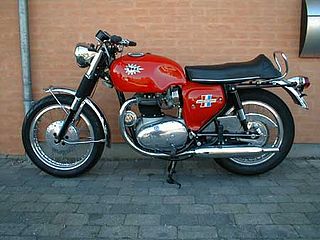
The BSA Spitfire is a high-performance BSA motorcycle made from 1966 to 1968 with model designations of MkII, MkIII and MkIV. Announced at the Brighton motorcycle show held during September 1965, it was based on the earlier BSA Lightning with a power-upgrade achieved by higher compression-ratio 10.5:1 pistons and two large-bore Amal GP carburettors with velocity stacks it was one of the first BSAs to have 12-volt electrics. At introduction in 1966, it was the fastest standard BSA ever produced and the fastest standard motorcycle tested by Motor Cycle with a best run at 123 mph and average of 119.2 mph The Spitfire was used for travelling Marshalls' course duties at the 1967 Isle of Man TT races.
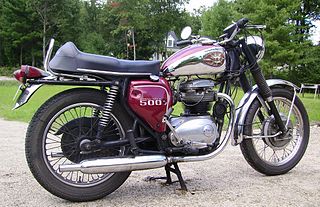
The BSA Royal Star was a Birmingham Small Arms Company (BSA) motorcycle whose new engine design paved the way for a range of successful unit construction twins. As well as giving a clean look to the engine, with the pushrod passages part of the cylinder block casting, unit construction reduced the number of places oil could leak from.
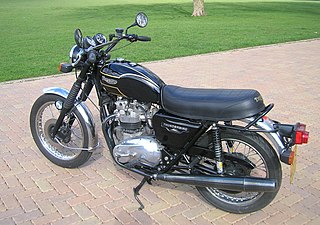
The Triumph TR65 Thunderbird is a motorcycle made by the Triumph worker's co-operative at the Meriden factory from 1981 to 1983. The TR65 was a reintroduction of the Triumph Thunderbird model name first used on the original 6T Thunderbird of 1949. A short stroke model, the Daytona 600 was designed in 1983 but not produced.

The BSA Lightning Rocket was a Birmingham Small Arms Company (BSA) motorcycle made in Birmingham. A highly-tuned version of the BSA A65R Rocket, it was BSA's bid to capture the potentially lucrative USA export market in the mid-1960s. Twin Amal 389/206 carburetors and high-compression pistons, combined with an optional close-ratio gearbox, gave lively acceleration.

The BSA Lightning is a British BSA 650 cc-class motorcycle made in Birmingham between 1965 and 1972.
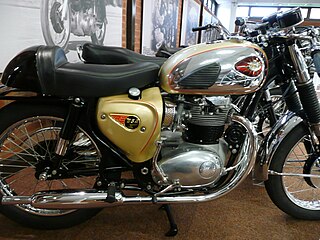
The BSA Lightning Clubman was a 650cc British motorcycle made by BSA at their factory in Birmingham between 1964 and 1965. Finished in gold and black the Lightning Clubman is now a highly sought after classic motorcycle. Due to the very limited production numbers replicas are created by enthusiasts from the BSA Lightning.

The BSA A7 was a 500cc motorcycle model range made by Birmingham Small Arms Company (BSA) at its factory in Armoury Road, Small Heath, Birmingham. The range was launched in 1946 using a 495 cc (30.2 cu in) long stroke engine. An improved 497 cc (30.3 cu in) version based on the BSA A10 engine was launched in 1950. The various A7 models continued in production with minor modifications until 1961/2 when they were superseded by the unit-construction A50 model.

The BSA C15 was a 250 cc single-cylinder ohv motorcycle manufactured by the British company BSA from September 1958 until 1967, and was BSA's first four-stroke unit-construction bike. For most of that period, after the introduction of 'Learner Laws' in 1961, a 250 cc was the largest capacity solo machine that a learner could ride unaccompanied when displaying L-plates in the United Kingdom. A road-going Sports derivative was added in 1961, and off-road versions, for Trials and Scrambles, were also available in the range.

The BSA Thunderbolt was a British motorcycle made by BSA at their factory in Armoury Road in Small Heath, Birmingham between 1962 and 1972. Fitted with a single carburettor it was capable of over 100 mph (160 km/h).
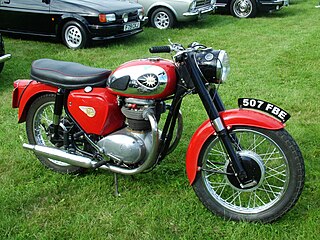
The BSA A65 Star was a Birmingham Small Arms Company (BSA) motorcycle aimed at the US market for unit construction twins. As well as giving a clean look to the engine, with the pushrod passages part of the cylinder block casting, unit construction reduced the number of places oil could leak from. A range of A65 Star twins was produced between 1962 and 1972.

BSA motorcycles were made by the Birmingham Small Arms Company Limited (BSA), which was a major British industrial combine, a group of businesses manufacturing military and sporting firearms; bicycles; motorcycles; cars; buses and bodies; steel; iron castings; hand, power, and machine tools; coal cleaning and handling plants; sintered metals; and hard chrome process.
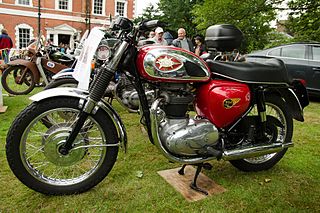
The BSA unit twins were a range of unit construction twin-cylinder motorcycles made by the Birmingham Small Arms Company (BSA) and aimed at the US market. A range of 500 cc (31 cu in), 650 cc (40 cu in) and 750 cc (46 cu in) twins were produced between 1962 and 1972, but they were really developments of the older pre-unit A7/A10 model range with less weight. The engines had a reputation for vibration, but acceleration was good for the time, to a top speed of 100 miles per hour (160 km/h).
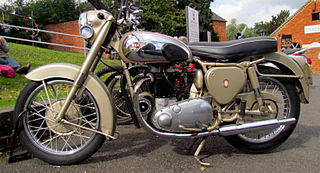
The BSA A10 series was a range of 646 cc (39.4 cu in) air-cooled parallel twin motorcycles designed by Bert Hopwood and produced by Birmingham Small Arms Company at Small Heath, Birmingham from 1950 to 1963. The series was succeeded by the A65 unit construction models.

The BSA B25 was a series of 250 cc (15 cu in) unit construction single-cylinder OHV four-stroke motorcycles made by the Birmingham Small Arms Company. Developed from the BSA C15, the machines were produced between 1967 and 1971. The B25 was the fastest British production 250.
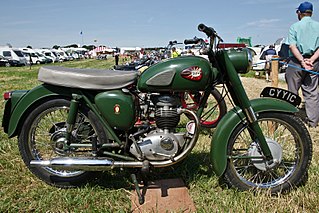
The BSA B40 was a series of 350 cc (21 cu in) unit construction single-cylinder OHV four-stroke motorcycles made by the Birmingham Small Arms Company. Developed from the BSA C15, the machines were produced between 1961 and 1967 for civilian use. Military versions were manufactured from 1967 to 1970. Around 14,000 machines were built in total.
References
- 1 2 Bacon, Roy (1988). British Motorcycles of the 60's. Osprey Publishing. p. 46. ISBN 1-85648-166-2.
- ↑ Kemp, Andrew; De Cet, Mirco (2000). Classic British Bikes. Abbeydale press. p. 160. ISBN 1-86147-136-X.
- 1 2 3 Clarke, R. M. (2003). BSA Twins - A50 & A65 Gold Portfolio 1962 - 1973. Brooklands Books Ltd. p. 24. ISBN 1-85520-337-5.
- ↑ "A fast run with a BSA" Motorcycle Sport, September 1964, pp.333-335. Accessed 17 January 2024
- ↑ "BSA Post War". britishcarcouncil.com. Archived from the original on 12 October 2010. Retrieved 22 October 2010.